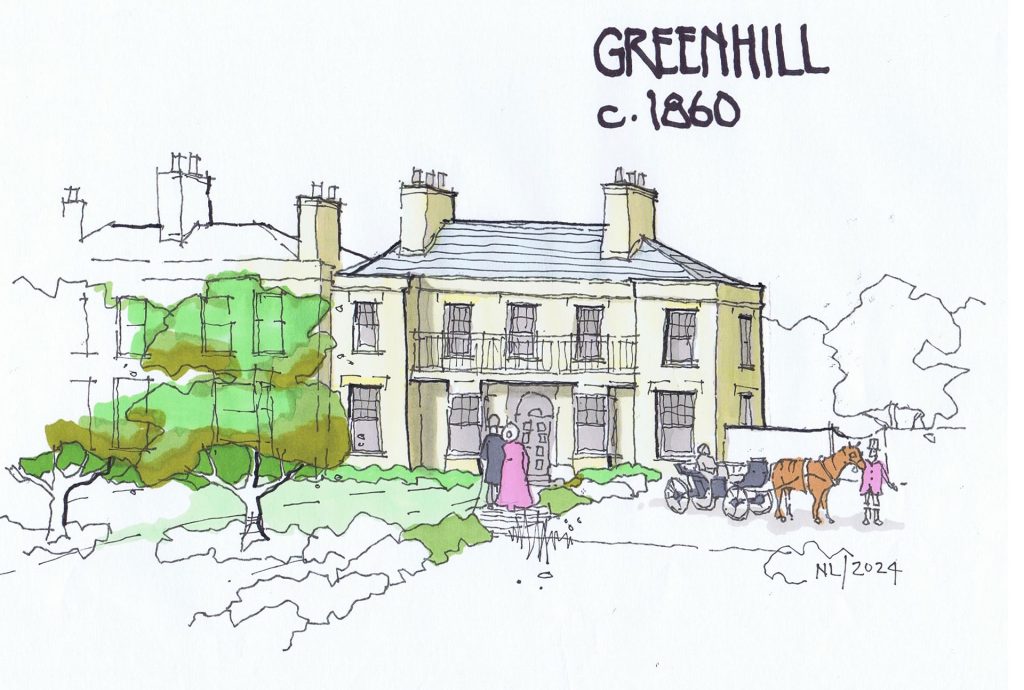Greenhill, Rhiwbina
By Nigel Lewis
A hundred and eighty years ago, at the time of the Tithe Map, a man named Henry Jones was living in Greenhill.
It was described as a ‘beautiful cottage’, almost opposite Deri Farm, with a pond and gardens, and surrounded by the fields of Ffynnon Wen Farm.
Greenhill was probably built on the site of an ancient croft Pwll-y-Winci (Weasel’s Pool). We know nothing about Henry Jones or Pwll-y-Winci. In 1841 there’s just an indication of an old cottage and garden to the north.
At the time, TW Booker was an ironmaster, a mill and colliery owner (and an aspiring MP and High Sheriff of Glamorgan). He was living a mile away, in his mansion Velindre. He was married with five children and had lots of servants. His youngest son John Partridge Booker (named after an influential uncle) was 7 years old.
Approaching his middle age, TWB wanted to ensure that his family were well provided for. He had already bought the local farms Ty Clyd and Llwyn Mallt and acquired Fforest (now Forest Farm), and now he was casting an envious eye on Greenhill to expand the Booker empire further.
He’d built a smart house (the Pines) for his eldest son Richard and now he was looking for a house for John Partridge Booker (I’ll call him JPB from now on). He’d shown little interest in the family business, so his father looked to turning him into a country landowner instead.
So, TWB bought Greenhill, and he also acquired quite a large chunk of the Ffynnon Wen Farm adjacent. In all, it amounted to 93 acres. Quite a decent estate for the young JPB.
In 1852, when JPB was only 18 years old, there is a newspaper report of his father demonstrating a modern reaping machine at his ‘beautiful cottage’. The demonstration was a triumph, and JPB was in attendance with his father, hob-nobbing with the local gentry.
Eight years later, in June 1860, JPB married Clara Langley in St John’s Church in Cardiff. The report of the wedding in the Cardiff Times is a joy to read (perhaps for another time!). JPB and his bride went on honeymoon to north Wales via the family estate in Herefordshire, returning later to Greenhill.
The earlier cottage, although beautiful, was clearly not big enough, or modern enough, for a Booker son. So, after acquiring Greenhill, TWB had it demolished and built a larger house instead. Just in time for the newly-weds to move into.
It was fashionably designed in the latest Georgian style, and was set in the grounds of the earlier Greenhill, at the end of the long driveway off Rhiwbina Hill. The old Pwll-y-Winci pool was retained and incorporated as a water feature within the newly landscaped gardens. We’re told that the view from the new house, across the immaculate lawns and orchard, towards the Bristol Channel, was spectacular.

The new Greenhill was now a six-bedroom mansion, with all of the modern facilities of the time. By far the biggest house in the area!
Alongside the house, were substantial stables for the horses and carriages, and there were kennels for the hounds as well. These however, were located further south (so the noise of the barking wouldn’t disturb the family). We’re told that for many years after, the Greenhill Hunt was well known for its fox and otter hunting!
Whilst we know its location, we don’t really know much about the house. There is a grainy photograph in the Cardiff Libraries collection showing Greenhill in later years. My sketch, based on the old photograph gives a flavour of how the new house might have looked in 1860.
Just after their return from their honeymoon, JPB and Clara were visited by the Velindra Band. A newspaper article reported that the band were there to present a pair of engraved solid silver spurs to JPB as a wedding present. They had been made by a saddler in Angel Street in Cardiff but weren’t finished in time for the wedding.
The bandmaster, in his address, hoped that JPB would wear the spurs ‘in many-a-good-hunt, with your capital hounds’ The band then played several pieces of music, on the lawn in front of the house (it being a ‘splendid moonlit night’). The tributes, speeches, and the already famous ‘Booker’ hospitality were noted at length.
I’m guessing that after the marriage, Clara, the new mistress stamped her mark on Greenhill, and it was probably altered and tweaked many times during the following years.
Clearly, a pair of newlyweds needed a small army of servants to look after them, and the census of 1861 tells us more. There were six servants:
A 60-year-old nurse and a 28-year-old nurse (?), a housekeeper, a cook, a housemaid, and a 22-year-old footman. There was no mention of grooms or gardeners, so they would have probably been living locally. Then of course, there were all the farm labourers and kennel boys!
Why the nurses? There is a tragic local tale that Clara might have lost a son early in the marriage. Later there were two daughters born to the Bookers at Greenhill. However, before he could enjoy his family, JPB himself died, aged only 34.
Clara, her children and the servants continued living at Greenhill. We know she was still there in 1875. I wonder what happened to Clara and the girls after?
The history of Greenhill after the Bookers is equally fascinating. We’ll have to explore this another time.
Member of AWEN@thelibrary (awen.cymru@gmail.com)

